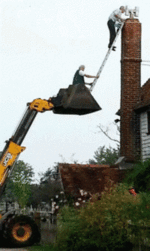Ladders on the Job Site
/September 2016
by Bill Christenson
 We have all been around and used portable ladders on project job sites but have we been doing so in a safe and code compliant manner? Ladder safety violations are one of the top ten cited rule violations during L&I inspections. As an employer, one must have a competent person train all employees in the proper use of ladders. Commercially purchased ladders (which should have a label indicating ANSI compliance) as well as field built ladders must meet the design and construction requirements of ANSI A14 ladder standards.
We have all been around and used portable ladders on project job sites but have we been doing so in a safe and code compliant manner? Ladder safety violations are one of the top ten cited rule violations during L&I inspections. As an employer, one must have a competent person train all employees in the proper use of ladders. Commercially purchased ladders (which should have a label indicating ANSI compliance) as well as field built ladders must meet the design and construction requirements of ANSI A14 ladder standards.
Ladders must be inspected by a competent person when first put into service and periodically thereafter. Any structural damage to ladder components such as bent, broken, or split side rails and/or rungs renders the ladder as unusable. Note that a damaged or defective side rail of a commercially manufactured ladder cannot be repaired by the user.
Proper selection of a ladder for intended use is required. Nonconductive type ladders need to be used where exposed electrical hazards exist. Stepladders are to be used only in the fully opened position and not as a non-self-supporting portable single ladder. Setup of ladders is to be on firm and level support or the ladder must be secured to prevent displacement. Ladders are not to be placed on other objects to gain additional height. When using a ladder to access an upper level, the ladder must extend three feet above the landing surface.
When climbing and descending ladders, the user must face the ladder and have both hands free to hold onto the ladder. Working from a ladder requires the ladder to be secured at the top and bottom. Fall protection must be provided when work on a ladder requires use of both hands and is more than 25 feet above the ground.
Ensure that ladders are properly and safely used on project sites by reviewing the full text of Washington State ladder requirements at www.lni.wa.gov/safety/rules/chapter/876/WAC296-876.pdfb .